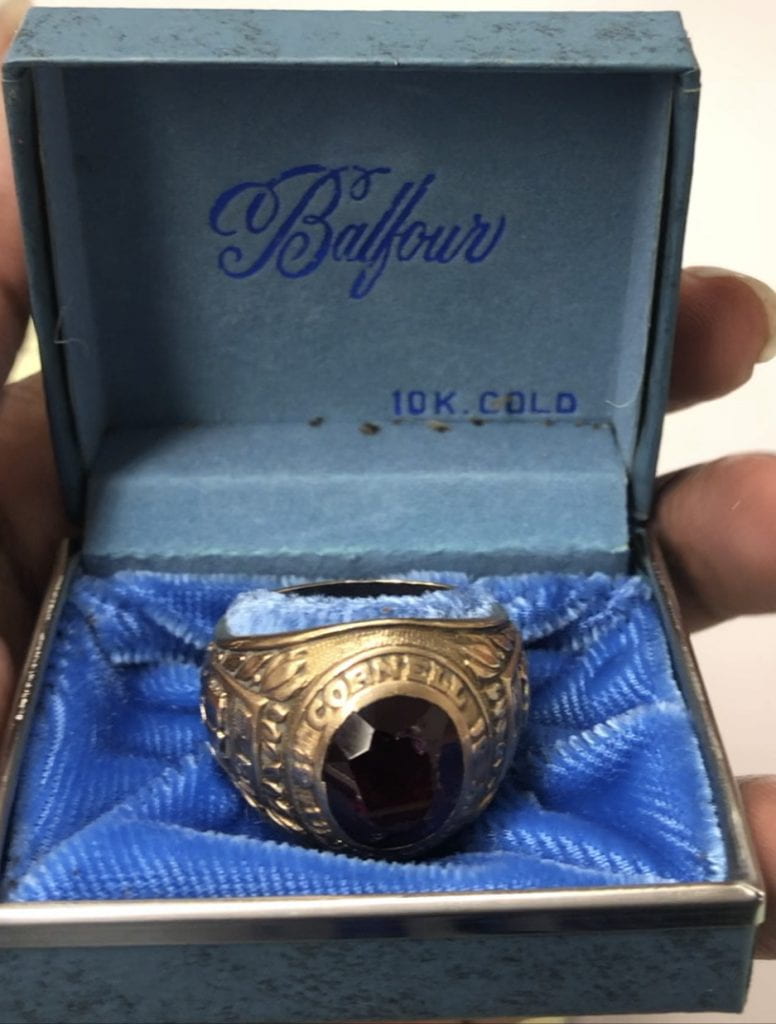This online blog post features materials protected by the Fair Use guidelines of Section 107 of the US Copyright Act. All rights reserved to the copyright owners.
Blog post by Sara Addai
Class rings. I, personally, have never understood their purpose. Yet another expensive piece of junk to commemorate 4 years of stress. However, when I looked at the Bernard Fleischer memorabilia in the Rare and Manuscript Collections, I began to realize why class rings were so cherished. Although I first set out to look at his beanie, Fleischer, an alumnus, kept quite a few other things from his days at Cornell: a sweater, many photos, an application booklet, chrome movie film rolls, and, of course, his class of 1961 ring (see Figure 1). Through these memorabilia, history is given to the ring, as it represents his friends and his cherished education throughout those 4 years no matter how difficult that may have been.
The class ring was introduced in America by the United States Military Academy at West Point in 1835. The graduates desired to be united even after their departures (Coetzer). Unlike now, they were not customizable and traditionally had a class crest on one side and the school crest on the other (Class Rings). The class crest was meant to be turned towards the heart when one was still in school and the school crest was closer to the heart when they graduated (Class Rings). Now the insignia is flipped away from oneself when they graduated to show it off and flipped towards oneself before they graduated to keep them focused on their goal. The ring is usually put on the right-hand ring finger, but in the past, it may have been on the left-hand ring finger, where wedding bands are traditionally supposed to go. This is because the ring finger has a vein, vena salvatella (previously known as Vena Amoris, that does not exist and is slightly different in its description), which leads up to the heart (Baker 73). All of this represents the camaraderie and morality shared within a class of young people about to indulge in the real world.
Fleischer’s ring was relatively generic from the yellow gold of the band to the ruby that centered it. The ring cost $38.99 which would be around $360 today (Webster). This is relatively cheaper than the class rings for sale currently at the price of $525 dollars (College Class Rings). The band is engraved with the Cornell crest surrounded by leaves on either side of the jewel, creating a formal balance. The crest contains two shields within them, one honoring The Empire State and the other to “salute the United States” (Breig) The book underneath the two mini shields is to depict the book that usually says “’ I would found an institution where any person can find instruction in any study.’” (Breig). The words “Cornell University” and the number 61 are engraved around the stone, notably facing in one direction so that it has a right way to be worn that can be faced towards the wearer or away from them. Also, according to the receipt, the stone is a “syn ruby – prismatite… faceted” (Bernard Fleischer Papers). The stone is likely red for the Cornell University colors.
While all this information is very telling of the pride Fleischer had for Cornell, it begs the question: Are class rings still relevant? My conclusion is no. When the United States Military Academy at West Point started the tradition, Cornell did not even exist yet. Meanwhile, the Ivies and other prestigious schools began to be the ones that had the rings. According to an article simply wearing a class ring “opened doors” (Mau). Today, everything is on record. Additionally, with the introduction of more advanced technology the average person can just take several photos and videos of their friends and keep their memories that way. A valid argument is that people just want different ways of remembrance like necklaces and tags. However, that does not make up for the reduction of sales, not only class rings but also yearbooks. A study in 2011 concluded that yearbook sales had declined by 4.7%. (Mau) While class rings are not tracked, they are notoriously not as popular (unless you are in the southern part of the United States). A big part of the decline is that people in modern society have access to more jewelry whereas before, class rings were one of the only options besides a wedding band. (Mau) Now, with so many other options, it seems like most people only get rings if they are very proud, rich, or traditional.
While I still will not be purchasing a class ring anytime soon, I can understand Fleischer’s enthusiasm for the piece. This ring was likely a way for him to carry around his college experiences and that was priceless to him. Although ring sales have declined the idea was always to unify a group of people that had shared a place for a few short years on their journey to become an adult in the brutal society that awaited them.
Sara Addai ‘25 is a first-year student at Cornell University who developed a love for writing and fashion in her childhood where she grew up in the small town of Decatur, IL. She enjoys being in the creative writing club, track and field club, and on the dance team. She hopes to continue indulging in fashion from around the world and write about it.
Works Cited
Baker, Frank. Anthropological Notes on the Human Hand. 1st ed., vol. 1, Wiley on Behalf of the American Anthropological Association, 1888.
Bernard Fleischer Papers, #37-5-3999. Division of Rare and Manuscript Collections, Cornell University Library.
Breig, James. “University Flag Design Evolved over Time.” Gettysburg Flag Works Blog, Gettysburg Flag Works, 22 Jan. 2015, https://www.gettysburgflag.com/blog/university-flag-design-evolved-time/. Accessed 4 December 2021.
“CLASS RINGS, MINIATURES, AND A-PINS.” West Point Bicentennial , 2001, https://www.west-point.org/family/bicent/rings.html. Accessed 4 December 2021.
Coetzer, Theo. “In a Class of Its Own: The Story of Class Rings.” Habilitate, Habilitate, 19 Nov. 2021, https://habilitateblog.com/in-a-class-of-its-own-the-history-of-class-rings/. Accessed 4 December 2021.
“College Class Rings.” Balfour, Balfour, 2021, https://www.balfour.com/shop/jewelry/rings/college-class-rings?smi=131305.
Mau, Dhani. “Do People Still Buy Class Rings?” Fashionista, The Arena Group, 2 July 2018, https://fashionista.com/2018/07/class-rings-jostens-jewelry-business. Accessed 4 December 2021.
Webster, Ian. “Inflation Rate between 1961-2021: Inflation Calculator.” $39 In 1961 → 2021 | Inflation Calculator, Official Data Foundation, 2021, https://www.in2013dollars.com/us/inflation/1961?amount=39. Accessed 4 December 2021.


